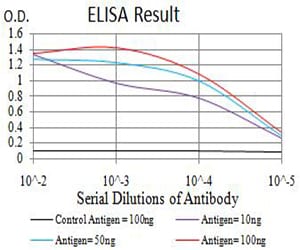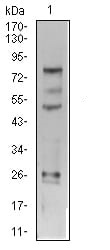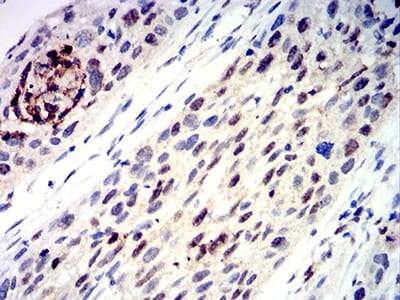


| WB | 1/500 - 1/2000 | Human,Mouse,Rat |
| IF | 咨询技术 | Human,Mouse,Rat |
| IHC | 1/200 - 1/1000 | Human,Mouse,Rat |
| ICC | 技术咨询 | Human,Mouse,Rat |
| FCM | 咨询技术 | Human,Mouse,Rat |
| Elisa | 1/10000 | Human,Mouse,Rat |
| Aliases | ERF1; TFAP2G; hAP-2g; AP2-GAMMA |
| Entrez GeneID | 7022 |
| clone | 3A11A5 |
| WB Predicted band size | 49.2kDa |
| Host/Isotype | Mouse IgG1 |
| Antibody Type | Primary antibody |
| Storage | Store at 4°C short term. Aliquot and store at -20°C long term. Avoid freeze/thaw cycles. |
| Species Reactivity | Human |
| Immunogen | Purified recombinant fragment of human TFAP2C (AA: 341-450) expressed in E. Coli. |
| Formulation | Purified antibody in PBS with 0.05% sodium azide |
+ +
以下是3篇涉及TFAP2C抗体的参考文献及其摘要概括:
---
1. **文献名称**: "TFAP2C regulates transcription in human naive pluripotency by opening enhancers"
**作者**: Cornacchia et al.
**摘要**: 本研究利用TFAP2C抗体进行ChIP-seq分析,揭示TFAP2C在人类原始多能干细胞中通过调控增强子区域维持多能性,并抑制分化相关基因表达。
---
2. **文献名称**: "AP-2γ is a critical regulator of female reproductive tract development"
**作者**: Kuckenberg et al.
**摘要**: 通过免疫组化(使用TFAP2C抗体)和小鼠模型,发现TFAP2C对雌性生殖管发育至关重要,其缺失导致输卵管和子宫结构异常。
---
3. **文献名称**: "TFAP2C promotes proliferation and resistance to therapy in breast cancer"
**作者**: Woodfield et al.
**摘要**: 该研究利用TFAP2C抗体进行Western blot和免疫荧光实验,证明TFAP2C高表达与乳腺癌细胞增殖加速及化疗耐药性相关,提示其作为治疗靶点潜力。
---
如需扩展,可补充表观遗传或癌症机制相关文献。
TFAP2C (transcription factor AP-2 gamma), a member of the AP-2 family of transcription factors, plays critical roles in embryonic development, cell differentiation, and proliferation. It regulates gene expression by binding to specific DNA sequences, influencing pathways involved in cell cycle control, apoptosis, and hormone signaling. TFAP2C is particularly noted for its role in trophoblast development, mammary gland biology, and germ cell maturation. Dysregulation of TFAP2C has been linked to cancers, including breast, ovarian, and germ cell tumors, where it often acts as an oncogene by promoting cell survival and metastasis.
Antibodies targeting TFAP2C are widely used in research to study its expression patterns, molecular interactions, and functional mechanisms. These antibodies enable techniques like Western blotting, immunohistochemistry (IHC), immunofluorescence (IF), and chromatin immunoprecipitation (ChIP). Validation typically includes testing on cell lines with known TFAP2C expression or knockout models to confirm specificity. Researchers employ TFAP2C antibodies to explore its involvement in cancer progression, stem cell pluripotency, and hormone-responsive pathways, particularly in estrogen receptor-positive breast cancer. Its role in regulating genes like *ERBB2* (HER2) and *CDKN1A* (p21) further underscores its therapeutic and diagnostic relevance. As a potential biomarker or drug target, TFAP2C remains a focus in oncology and developmental biology studies.
×